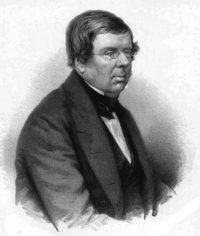William Parsons, 3rd Earl of Rosse
|
|
William Parsons, 3rd Earl of Rosse (June 17, 1800 – October 31, 1867) was an Irish astronomer.
He became the third Earl of Rosse when his father died in 1841. Prior to this, his title was "Lord Oxmantown".
In the 1840s, he built his "Leviathan of Parsonstown" 72-inch telescope at Birr, Ireland (then called "Parsonstown") in County Offaly, which was for many decades the largest telescope in the world. He had to invent many of the techniques he used in constructing this telescope, both because its size was without precedent and because earlier telescope builders had guarded their secrets or had simply failed to publish their methods. It was considered a marvelous technical and architectural achievement and images of it were circulated widely within the British commonwealth.
The telescope mirror was made from speculum metal. Because it tarnished so rapidly in the damp climate, the mirror had to be repolished every six months, and so Lord Rosse had two mirrors built so that one could be used while the other was being repolished. Building of the telescope had to be suspended during the Great Potato Famine, but in 1847 it was put into service. The light-gathering ability exceeded expectations, enabling 18th magnitude stars to be observed for the first time. However, the Irish sky was not kind to astronomy, and due to weather conditions very few good nights of viewing were available per year.
Lord Rosse carried out pioneering astronomical studies and discovered the spiral nature of some nebulas, today known to be spiral galaxies. The first spiral galaxy he detected was M51, and his drawings of it closely resemble modern photographs (today it is known as the Whirlpool Galaxy).
He named the Crab Nebula, based on an earlier drawing made with his older 36-inch telescope in which it resembled a crab. A few years later, when the 72-inch telescope was in service, he produced an improved drawing of considerably different appearance, but the name stuck anyway.
A main component of Rosse's nebular research was attempting to resolve the nebular hypothesis, which posited that planets and stars were formed by gravity acting on gaseous nebulae. Rosse himself did not believe that nebula were truly gaseous, but rather were made up of such an amount of fine stars that most telescopes could not resolve them individually (that is, he considered them stellar in nature). Rosse and his technicians claimed to resolve the Orion nebula into its individual stars, which would have both political and cosmological implications, as at the time there was considerable debate over whether or not the universe was "evolved" (in a pre-Darwinian sense), a concept Rosse disagreed with strongly. Rosse's primary opponent in this was William Herschel, who used his own instruments to claim that the Orion nebula was a "true" nebula, and discounted Rosse's instruments as flawed (an insult Rosse returned about Herschel's own). In the end, neither man (or telescope) could establish sufficient scientific authority in its results to solve the question by themselves (the convincing evidence for the gaseous nature of the nebula would come later from spectroscopic evidence, though it would not resolve the philosophical issues).
In addition to his astronomical pursuits, he served as a member of Parliament from 1821 to 1834, an Irish representative peer after 1845, president of the Royal Society (1848–1854), and chancellor of the University of Dublin (beginning in 1862).
He married Mary Field in 1836 and they had four children, all sons. The eldest, Lawrence Parsons, succeeded him as Earl of Rosse and continued some astronomical observations; another son, Charles Algernon Parsons, is known for his commercial development of the steam turbine. Another son, Richard Clere Parsons apparently made a name for himself building railways in South America.
External links
- The Leviathan of Parsonstown (http://labbey.com/Telescopes/Parsontown.html)
- Birr Castle website (http://www.birrcastleireland.com/)
- thePeerage.com entry (http://www.thepeerage.com/p1279.htm#i12787)
Obituary
- MNRAS 29 (1869) 123 (http://adsabs.harvard.edu//full/seri/MNRAS/0029//0000123.000.html)
| Preceded by: The Marquess of Northampton | President of the Royal Society 1848–1854 | Succeeded by: The Lord Wrottesley
|

